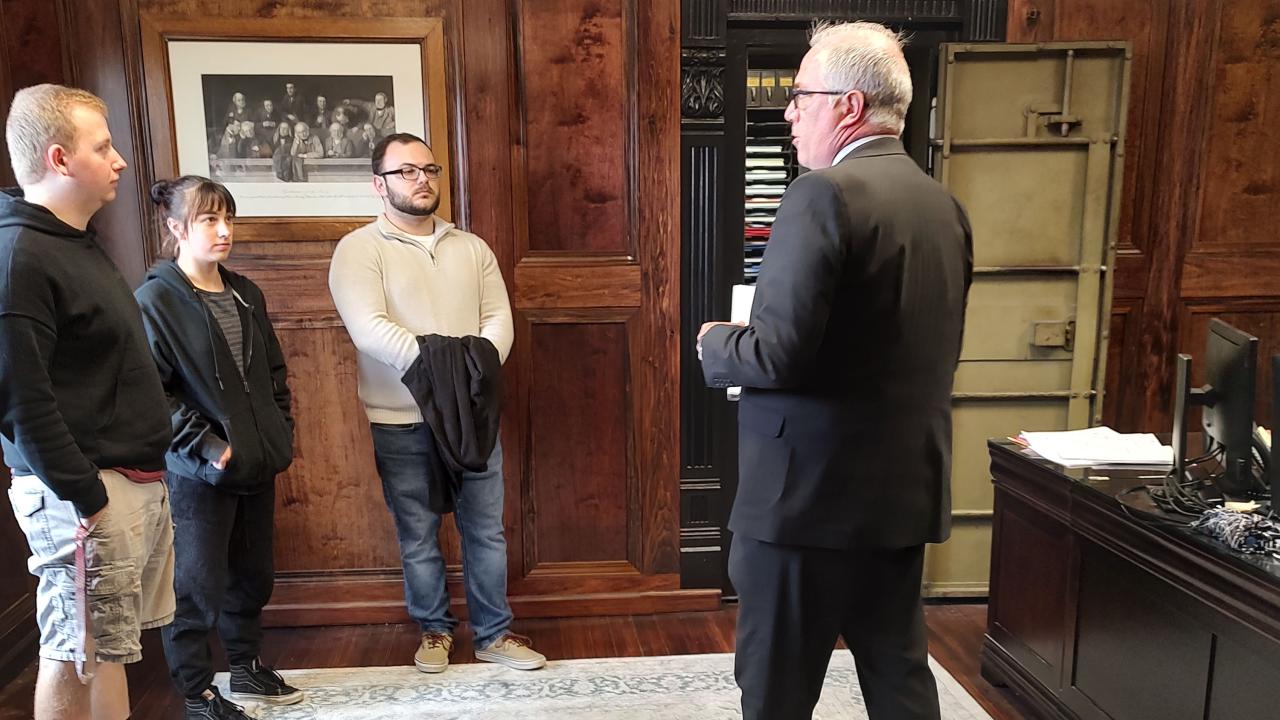Written by Sophia Veneziano
Marion Star USA TODAY NETWORK
The history of the Marion County Courthouse came alive for a group of students at The Ohio State University at Marion when they toured the building Oct. 19 to learn about its former glory and gauge interest in a potential internship program. On the tour led by Marion County Common Pleas Judge Warren T. Edwards, the class of Ohio State Marion history majors were captivated by much of the building’s history. They were especially excited by the hidden vault of documents discovered by Edwards that still is primarily untouched, according to Associate Professor of History Margaret Sumner.
“A lot of students were struck, obviously, with this hidden vault,” Sumner said.
“I think that was the ‘wow’ factor for them. I didn’t tell them too much – I told them the judge discovered this secret vault and I was teasing them about it being sort of Harry Potter-esque, joking about it, but I think once they entered that space between his administrative assistant’s office and his chambers, I think they were really struck by that.”
Edwards and Sumner have been working out details of launching an internship program where students can earn course credit toward their history majors for helping organize and catalogue the documents in the vault.
“They would receive school credit for coming down and helping us catalogue, preserve, scan, the documents in the vault area,” Edwards said.
As the history majors studying the “introduction to the discipline of history” with Sumner walked through the courthouse, there were exclaims of “oh wow,” and “that’s so cool” as they took photos and asked questions.
Edwards explained to them that the oldest document he has found dates back to 1831, and he believes the vault holds the records from a famous case in 1839 when an escaped slave, Bill Anderson, was granted his freedom by the court in a controversial decision at the time.
“I think the documents from that may be in this room, but I don’t have the manpower to find them and our current clerk of courts, whose files these technically are, does not know what this room consists of,” Edwards said.
Details are still being worked out on both ends for the budding partnership, but Edwards and Sumner hope to send a team of students in as early as the summer of 2023.
“Hopefully we will send a couple students, maybe starting this summer, in with the judge and they’ll go through some of those boxes, and I don’t know what’s in there. They don’t know what’s in there, and it’s going to be a total project of discovery,” Sumner said.
“That’s what real history is. I’m trying to get them to have some real-life experiences of what it means to ask historical questions.”
After taking the tour of the courthouse, each student provided a reflection on what he or she learned or found meaningful.
One student, Elizabeth Passias, wrote that she believed the documents in the vault were an important way to see into the past of Marion County.
“I think by going through the documents the judge can teach people the historical value of this county. Even though they are legal documents, they are a gateway into the past. Historians can learn about citizens’ daily lives, possibly identify patterns. . . learn about political, social and moral ideologies that citizens of Marion had throughout the years,” Passias said.
Sumner said the program would start small with one or two students joining Edwards to research the history of the building’s construction, curate biographies of former judges and their important cases and catalogue the documents in the vault.
After the tour, one student was already ready to get started, Sumner said. “I already have one student who out in the parking lot was like, ‘Where can I sign up? I want to work with the judge,’” she recalled.
Sumner also said an important part of this potential internship program would be exposing students to the inner workings of the courthouse and the judges, lawyers and other staff that work there as many of her students are interested in pursuing law school but don’t know what a courtroom is like in practice.
Even on their tour, students got to experience the buzz of the courthouse while a jury deliberation took place. Edwards said he enjoyed sharing the history of the courthouse with such a captive audience.
“Some of things when people see them, especially people with an interest in history, they’re just kind of like, ‘Wow,’ and there was a lot of that, but then we stood around and talked for a few minutes in the parking lot where I kind of end the tour, and a couple of them were ready to sign up for internships right away,” he said.
Story by: Sophia Veneziano (740) 564 - 5243 | sveneziano@gannett.com
